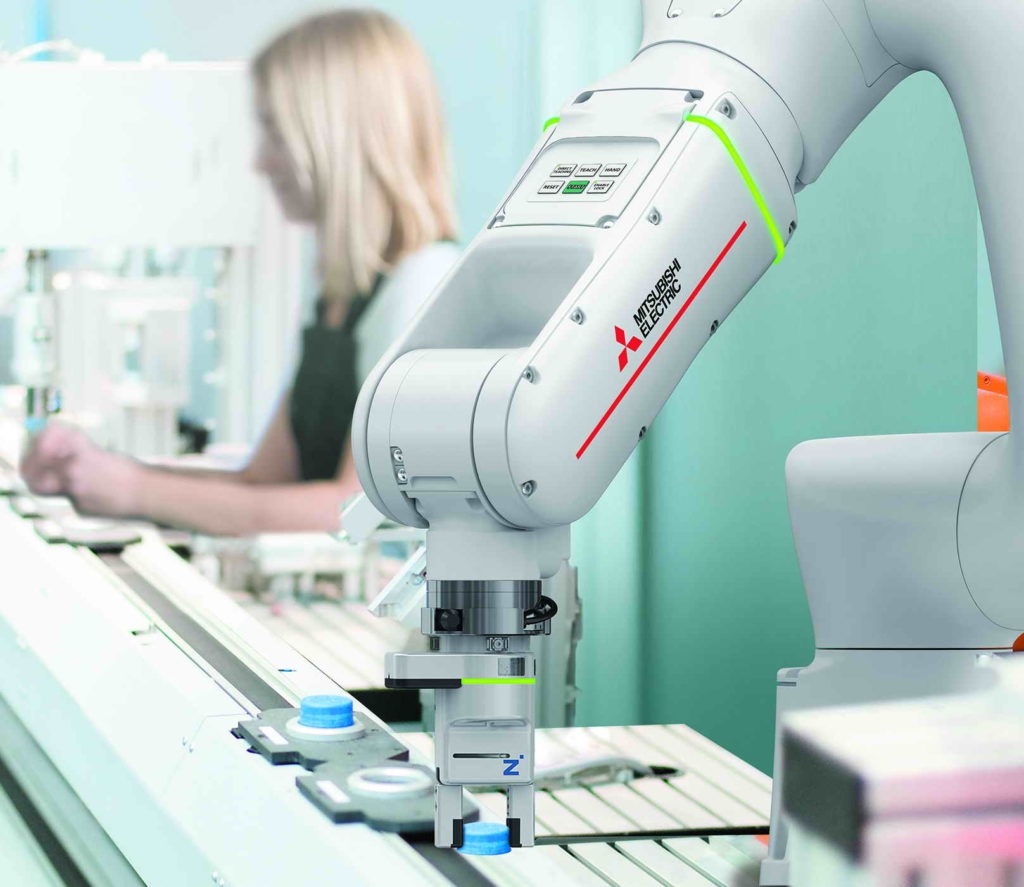Cobots in manufacturing bring new skills and opportunities

Futureproofing manufacturing and assembly operations with cobots is easier than people think. Shop floor cobots in manufacturing working alongside operators are no longer the future, but the present. Whether used for assembly, packaging, warehousing, maintenance or training, collaborative solutions are changing the way producers work. Easy to program and install, they are also ideal for entry-level automation applications and working alongside people.
Barry Weller, Robotics Manager at Mitsubishi Electric, considers the benefits of cobots (collaborative robots) in manufacturing and their ease of integration.
Collaborative and industrial robots are suitable for a wide range of production processes. In the last ten years, global sales of industrial robots tripled to 422,000 units shipped worldwide annually1. Cobots are a growing part of this2.
Cobots in manufacturing
Driving the high adoption rates are the immense production benefits they can deliver. Cobots in manufactring improve productivity and throughput while delivering high accuracy and repeatability, leading to consistent production quality.
Collaborative robots are attractive, as they need smaller initial investments. Moreover, they are simple to integrate into manufacturing setups as they need no barriers to ensure a safe working environment. One of the biggest advantages is how intuitive and easy they are for operators to use and interact with.
Instinctive programming
Cobots use visual programming languages and graphical user interfaces that let users sequence the process without any coding. This reduces programming complexity. For example, Mitsubishi Electric’s MELFA Assista cobots work with an intuitive, touch-enabled engineering software, called RT VisualBox. This software supports the creation of operating sequences by linking block diagrams in a chain of events.
A software wizard within RT VisualBox connects external devices like vision systems to the cobot and guides users through each step of the setup. To make things simpler, the MELFA Assista offers an extra hand-guided teaching function. The operator guides the cobot into position manually and adds it to the work sequence by pressing a button.
These functionalities help operators create high performance applications without any prior programming knowledge. It streamlines installation and reduces setup costs and time. This helps companies by growing their factory automation skills and confidence. It also reduces the need for operators to have an elevated level of expertise in robotics or programming. Businesses can increase their automation literacy and create effective setups that meet their specific needs and requirements.
Developing cobot skills
Finally, the ease of use of a cobot such as the MELFA Assista helps upskill the workforce. Working with robots and other automation components in smart factories is important for the next generation of automation engineers. It means being able to set up these machines, interact and inspect them as well as conduct maintenance activities.
Improving skill provision systems and upgrading education policies to advance technology skills is becoming important. To address these educational needs, Mitsubishi Electric provided Redcar & Cleveland College with an RV-F series articulated arm robot. It helps them consider where using robots in wider roles improves productivity, particularly for heavy and dirty tasks.
Cobots in manufacturing support this development as they remove entry barriers and contribute to increased ‘robot literacy’ across the workforce. Significantly, by implementing cobots, organisations can enjoy automated processes and support their staff in developing key skills in the longer term.
References
1Statista Research Department. (2021). Industrial robots worldwide – statistics & facts.
2Statista Research Department. (2021). Collaborative robots’ share of the worldwide industrial robot market 2017-2019.
Recent blog posts
